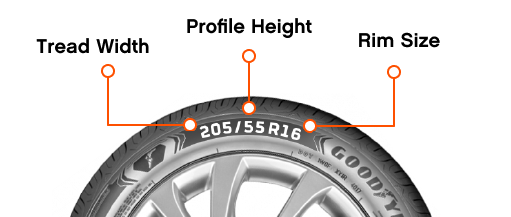Complete 3 steps to buy & book online


Every tyre has a speed rating and load index that indicates the maximum speed and weight your tyre can sustain. It may not be necessary for every driver to know this, but for drivers of sportscars, off-roaders and vehicles that carry heavy loads, it’s particularly important to know the weight and speed for which your tyres are designed.
Tyre Load Index
Your tyre’s load rating, also known as its load index or load carrying capacity, is a numerical value that indicates the maximum amount of weight it can carry. Each Load Index number represents a different maximum weight in kilograms.
Load Index Chart
| Load Index | Load in kg per Tyre |
| 60 | 250kg |
| 70 | 335kg |
| 80 | 450kg |
| 90 | 600kg |
| 100 | 800kg |
| 110 | 1060kg |
| 120 | 1400kg |
| 130 | 1900kg |
All tyres must have a suitable load index for the vehicle it’s fit to. If you were to exceed the maximum weight your tyre could handle, it would not only impact the performance of your vehicle, but could also put you and other drivers at risk. When replacing your tyres, it’s not only unsafe, but also illegal to install new tyres with a lower load index than the vehicle’s original tyres.
Tyre Speed Rating
The speed rating of your car indicates the maximum speed the tyre can safely and legally tolerate. It’s represented by a letter, with each letter indicating a different speed capability.
Speed Rating Chart
| Speed Rating | Max Speed |
| N | 140km/h |
| P | 150km/h |
| Q | 160km/h |
| R | 170km/h |
| S | 180km/h |
| T | 190km/h |
| U | 200km/h |
| H | 210km/h |
| V | 240km/h |
If you were to exceed the limit of your tyre’s speed rating, it may not perform as designed. It’s also illegal and dangerous to fit your vehicle with tyres with a lower speed rating than the original tyres it came with, as it could impact your vehicle’s handling and safety. You can, however, replace your tyres with ones that have a higher speed rating.
How to find your tyre’s load index and speed rating
You should be able to find the vehicle manufacturer’s recommended tyre load index and speed rating in the manual that came with your vehicle. Sometimes, it’s also marked on the driver’s side door. If all else fails, you’ll be able to find it on the tyre’s sidewall, next to the tyre size marking.
How to read your tyre’s load index and speed rating
The load index and speed rating is represented as a number and letter at the end of your tyre markings.
For example, if the marking inside your tyres is 265/75R16 120R
Then your load rating is 120 and your speed rating is R.
If the load rating for the tyre is 120, the maximum permissible load of the tyre is 1400kg. If the speed rating for the tyre is R, it can sustain a maximum speed of 170km/h.
Which load rating and speed index is right for your vehicle?
You must meet or exceed the load rating and speed index listed on your vehicles tyre placard when replacing your tyres.
For owners of certain vehicles, such as trucks and trailers, off-road vehicles and track and sportscars, it’s particularly important that you understand how much weight your tyres can carry, and what speed they can sustain.
Trucks, utes and trailers
Any vehicle that carries a lot of heavy equipment needs a tyre that can sustain a heavy load. These vehicles should be fit with tyres with a high load index.
Off-road vehicles
Tyres fit to off-road vehicles typically need to carry a heavier vehicle. These tyres should have a lower speed rating and a higher load index.
Sportscars and performance vehicles
Vehicles made for speed and performance, such as sportscars, should be fit with tyres that have a higher speed rating and lower load index.
Need help?
Our team of tyre experts is ready to assist you in finding the perfect tyres for your vehicle. Give us a call today at 13 23 81 to receive personalised guidance and recommendations.
Alternatively, you can visit our website to locate the nearest store and explore our wide range of tyres




